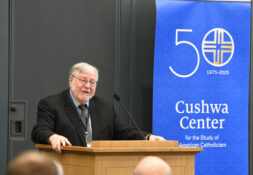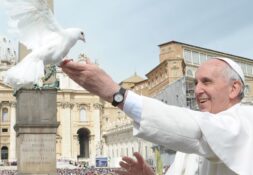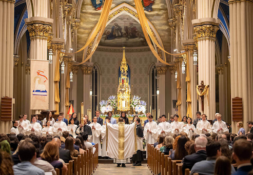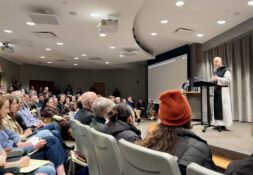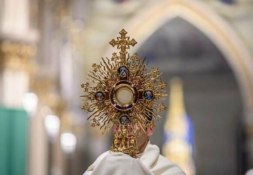Notre Dame theology professors publish children’s book about the saints
Paraclete Press recently published Saints: A Family Story, a children’s book co-written by the father-daughter pair of Notre Dame theologians John and Catherine Cavadini. The illustrations for the book were painted in watercolor by Anastassia Cassady, a Ukrainian Catholic painter and photographer who lives in South Bend.
The book features the lives of a variety of holy men and women, as recent as Pope St. John Paul II and as early as St. Joseph. It also features lesser known figures such as Bl. Herman of Reichenau who, despite difficulties with speaking and writing, wrote the Salve Regina and Veni Creator Spiritus, and Ss. Cosmas and Damian, twins and physicians martyred near Rome in the third century.
Catherine shared her inspiration for writing the book in an interview with the Rover: “We have lost our sense of how to write about the saints well, such that their personality and not just biographical data comes through.” She continued, “You need, when you tell their story, to have [the saint’s] personality come through so that you can see in them what the love of God meant to them and how it formed them and even transformed them.”
Catherine had been collecting the stories of saints that her father had been telling to his grandchildren (her own children included). One Lent during the COVID pandemic, as Catherine recalled, her father had his grandchildren write down the name of a saint that they wanted to learn about and give it to him so that he could share these saints’ stories with them.
She continued,“Most of them picked [their own patron saints],” which is why the book features saints like St. Anna the Prophetess, rather than St. Anna, Christ’s grandmother, as Catherine’s daughter Anna is named after the prophetess who accompanied Simeon in the temple during Christ’s Presentation.
According to Catherine, the book is subtitled “A Family Story,” because she and her father wanted to show how family is an integral part of the journey of faith. For example, Ss. Zélie and Louis Martin, who are included in the book, are the parents of St. Thérèse of Lisieux. The book emphasizes their familial connection by asserting that St. Thérèse learned the “Little Way” from her parents.
While a main focus, the book isn’t limited to discussing biological bonds. It points to St. Rose of Lima, who brought herself to holiness by modeling herself on St. Catherine of Siena, another saint featured in the book.
Most of the holy men and women in the book are saints; it also includes three blesseds, one venerable, and two servants of God. Catherine explained this decision: “I think it’s important to include [blesseds, venerables, and servants of God] to show the reader it’s not just those who’ve gone through the whole process.” In an interview via email, John added, “Venerables, and even servants of God are … people who have lived holy lives, some of them more contemporary and so they can expand our contemporary imagination regarding what a holy life looks like.”
One saint that seems to be missing from the book is Mary, the Mother of God. About this, Catherine said that “[Mary’s] story would be very challenging to write” because “we don’t have it.” She also said she wouldn’t know where to end Mary’s story, as she appeared many times at various places, like Lourdes or Akita. John added that “Mary really deserves a book of her own taking up each title by which she is venerated both across time and across cultures.”
John concluded by saying that he and Catherine hope that, through reading their book, “Young people can find their imaginations growing as to thinking about what holiness might look like and therefore inspire them to find an adventure in holiness for themselves.”
Now that it has been officially announced that Bartosz’s residence hall (Fisher) will be torn down, Bartosz is sad. Send him your condolences at bartosz.chramiec@nd.edu.
Photo Credit: Paraclete Press
Subscribe to the Irish Rover here.
Donate to the Irish Rover here.
